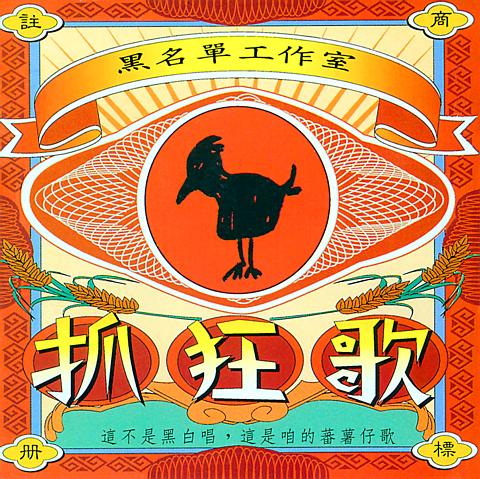Musician Joe Wang (王明輝) remembers 1989 well. Political demonstrations brought turmoil to Taiwan society. Long-suppressed social forces were being released from long-term dictatorship. And the first official opposition party -- the DPP -- was using a strategy of protest to clash with the KMT regime.
It was also the year that an unprecedented Taiwanese language album appeared on the market, titled Songs of Madness (抓狂歌) and subtitled "These aren't crap songs, these are our yam songs" (yam is a symbol of Taiwan). It was produced by Black List (黑名單工作室) -- comprised of Wang, Io Chen (陳主惠) and Keith Stewart from the US. The album recruited then underground singers such as Chen Ming-chang (陳明章) and Lin Wei-tseh (林瑋哲). The "mad songs" in the album mainly satirized the political situation at that time and ridiculed people's powerlessness in a hyper but chaotic society.
For example, in "Democracy Bumpkin" (民主阿草):

I went strolling in the morning, seeing troops of armed policemen, wondering if they were preparing to fight communists.
My neighbor told me it was against protesters. He said he is something called DPP and it's fun to protest.
There were a bunch of old guys occupying seats in the congress, using our tax money for their medical fees. There were old mainlanders serving the country for 40 years but gaining nothing. I want to protest. I want to protest, they shouted.
"We wanted to record the happenings of Taiwan's society and provide a space for people to think -- through music," Wang recalls. When it comes to protest singers or bands, one might think of Bob Dylan in the 60s, the UK's Billy Bragg in the 80s or Rage Against the Machine in the 90s. In Taiwan, in the late 80s and early 90s, it was Black List and its frontman Joe Wang.
For Wang, Black List's role was to find a way for intellectuals to intervene through music. "Since Lo Ta-yu (羅大佑) in the early 80s, [who sang "Lukang Small Town"], we had not heard an intellectual's voice in the music scene," he says. "For us, we didn't quite believe in sentimental inspiration when we wrote music."
Songs of Madness breaks down the convention of Taiwanese language pop songs, which contain exaggerated elements of lament, either about lost love or good times that can't be relived. But Black List's social criticism cloaked in cynical Taiwanese rap and folk songs, which soon became popular among college students and young middle class. Songs of Madness was labeled by media and critics as the New Taiwanese Songs. Soon, Chen Ming-chang and Lin Wei-tseh became popular songwriters and producers. Chen wrote and produced many award-winning scores for director Ho Hsiao-hsien (侯孝賢) and Lin is now producer of the award-winning singer Faith Yang (楊乃文). But for Wang, who insists on staying aloof from the mainstream, he knew that the New Taiwanese Song movement was no more than a market gimmick. "After Chiang Hui (江蕙) swept away KTV hit rate, the mainstream started to embrace sentiment ballads again," he said.
Wang didn't stop producing alternative music during the 10 years following Songs of Madness, a period during which his star has slowly dimmed. Gradually, Taiwanese language diminished as an essential tool of protest, so Wang shifted his focus to other subjects of social struggle -- for instance, labor and aboriginal issues. "We [Black List] are the only group who cares about the issue of class in Taiwan society," Wang says.

This month the government ordered a one-year block of Xiaohongshu (小紅書) or Rednote, a Chinese social media platform with more than 3 million users in Taiwan. The government pointed to widespread fraud activity on the platform, along with cybersecurity failures. Officials said that they had reached out to the company and asked it to change. However, they received no response. The pro-China parties, the Chinese Nationalist Party (KMT) and Taiwan People’s Party (TPP), immediately swung into action, denouncing the ban as an attack on free speech. This “free speech” claim was then echoed by the People’s Republic of China (PRC),

Exceptions to the rule are sometimes revealing. For a brief few years, there was an emerging ideological split between the Democratic Progressive Party (DPP) and Chinese Nationalist Party (KMT) that appeared to be pushing the DPP in a direction that would be considered more liberal, and the KMT more conservative. In the previous column, “The KMT-DPP’s bureaucrat-led developmental state” (Dec. 11, page 12), we examined how Taiwan’s democratic system developed, and how both the two main parties largely accepted a similar consensus on how Taiwan should be run domestically and did not split along the left-right lines more familiar in

Most heroes are remembered for the battles they fought. Taiwan’s Black Bat Squadron is remembered for flying into Chinese airspace 838 times between 1953 and 1967, and for the 148 men whose sacrifice bought the intelligence that kept Taiwan secure. Two-thirds of the squadron died carrying out missions most people wouldn’t learn about for another 40 years. The squadron lost 15 aircraft and 148 crew members over those 14 years, making it the deadliest unit in Taiwan’s military history by casualty rate. They flew at night, often at low altitudes, straight into some of the most heavily defended airspace in Asia.

Many people in Taiwan first learned about universal basic income (UBI) — the idea that the government should provide regular, no-strings-attached payments to each citizen — in 2019. While seeking the Democratic nomination for the 2020 US presidential election, Andrew Yang, a politician of Taiwanese descent, said that, if elected, he’d institute a UBI of US$1,000 per month to “get the economic boot off of people’s throats, allowing them to lift their heads up, breathe, and get excited for the future.” His campaign petered out, but the concept of UBI hasn’t gone away. Throughout the industrialized world, there are fears that